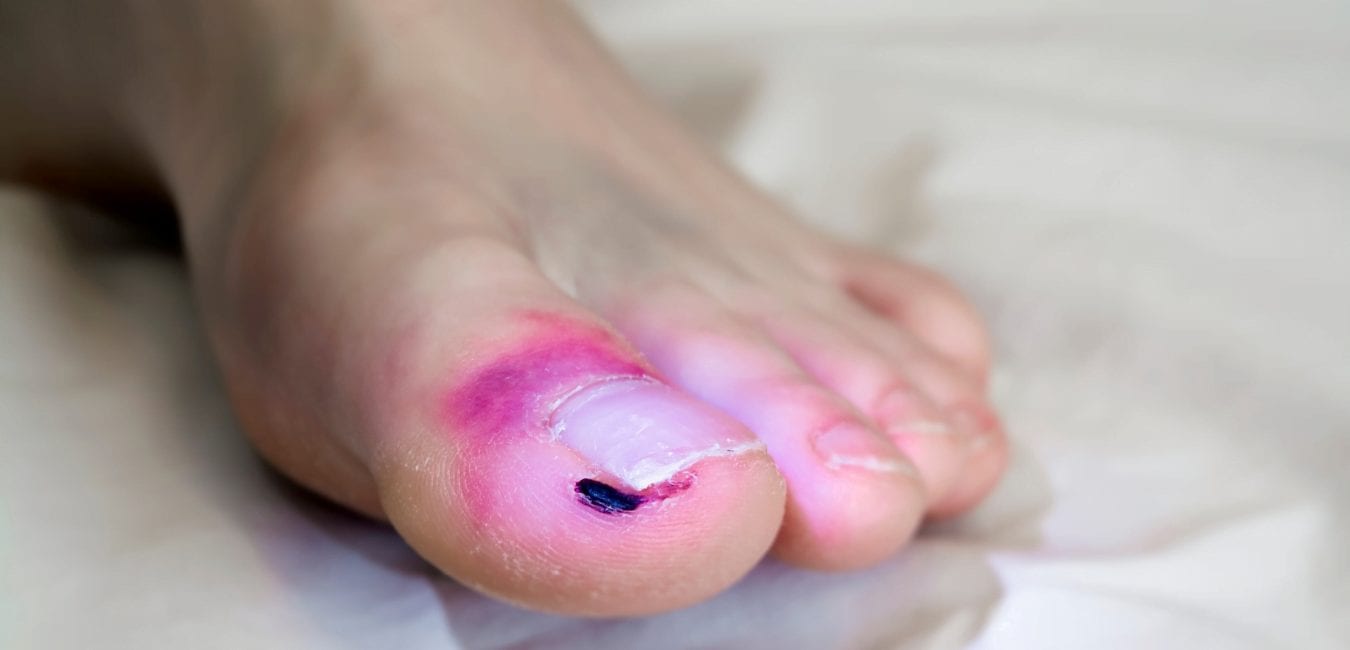Overview
Big toe joint pain is an incredibly common symptom that affects millions of people.
If you have joint pain big toe, you are most likely confused about the potential trigger of this condition, as well as what you can do about it. However, for joint pain treatment, you first need to identify the underlying cause. We have complied an extensive list for joint pain big toe below.
What is the big toe joint?
The hallux metatarsophalangeal joint connects the first bone on the top of your foot to the base of your big toe.
The big toe joint is often subject to pain and different injuries that interfere with your daily life, which makes simple tasks very challenging to complete.
Any injury to the bones, ligaments, or muscles triggers an inflammatory response, leading to the classic symptoms of joint pain big toe.
In this article, we will discuss the causes, symptoms, and treatment options for joint pain big toe in the workplace.
What causes big toe joint pain?
There are several mechanisms that trigger big toe pain, including:
1. Arthritis
The American Orthopaedic Foot and Ankle Society states that hallux rigidus is the most prevalent cause of arthritic pain in the big toe. According to the same report, this condition affects 2.5% of people over the age of 50.
Symptoms of this condition include pain, especially when performing physical activity that places pressure on your toe and feet.
Other symptoms include:
- Edema (i.e., swelling) of the big toe joint
- Reduced range of motion of the big toe
2. Ingrown toenail
An ingrown toenail occurs when the nails of the toe grow in the sides, leading to pain and swelling. The symptoms get worse during walking or when wearing shoes.
Other symptoms include:
- Swelling and tenderness of the big toe
- Soreness of the toe
- Skin discoloration (i.e., darkness)
3. Gout
Gout is an inflammatory condition where uric acid builds up in different articulations. The American College of Foot and Ankle Surgeons (ACFAS) points out that the big toe is very commonly affected.
Symptoms of gout of the big toe:
- Joint pain big toe (worse at night)
- Swelling and warmth of the articulation
- Shiny skin over the big toe
4.Turf toe
Turf toe mainly occurs after a physical injury of sporting activities. May be the Cause of your joint pain big toe
Athletes who play on artificial turf are more likely to develop this condition due to repetitive bending of the big toe.
Symptoms of turf toe are:
- Pain that gradually builds up as you perform more physical activity
- Swelling of the big toe
- Loss of mobility of the joint
6. Bunion
A bunion, or hallux valgus, is a common condition that affects the base of the big toe, where the joint protrudes outward, creating a visible bump on the side of the foot.
Symptoms of hallux valgus include:
- Big Toe Joint Pain and soreness
- Swelling of the big toe joint
- Redness around the joint
- Numbness of the big toe area
- Movement restriction
- Burning sensation
The treatment options for Joint pain big toe
After talking your medical history, your doctor will perform a physical examination to learn more about the characteristics of your pain. To identify the etiology (i.e., cause of the joint pain big toe ), your doctor may order a few imaging tests (e.g., X-ray, CT scan, MRI) to visualize any abnormalities in your big toe. Please keep in mind the big toe joint pain you are experiencing is common, don’t let
The following treatments can all be optional to relieve pain and reduce neck stiffness:
Cryotherapy – the use of cold to remove inflammatory cytokines from the site of injury improves pain and restores neck mobility. Expensive but may be effective at treating joint pain big toe
Thermotherapy – heat therapy expands the vessels around your big toe, which improves blood circulation and removes toxins and inflammatory compounds.
Joint Supplements – Are a great option. Though it should be noted that most supplements are just a gimmick. We recommend Synthaflex 13 . Clinically studied, pharmaceutical grade ingredients with proven results. This is a great option for joint pain treatment. Best for individuals looking to treat big toe joint pain naturally and effectively.
Stretching therapy – regular stretching and physical therapy can be great for patients with joint pain big toe.
Painkillers – your doctor will start by prescribing over-the-counter painkillers, such as acetaminophen (i.e., Tylenol). If the treatment doesn’t work, other medications (e.g., codeine, morphine) may be beneficial.
Muscle relaxants – these drugs prevent jerky contractions of the muscle fibers, which improve symptoms of pain.
Corticosteroid injections – if conventional pharmacological treatments fail, your doctor may recommend the injection of corticosteroids inside the big toe joint.
Surgical intervention – if all the treatments above do not improve the patient’s symptoms, surgery may be the last resort.
Alternative solutions for joint pain treatment
Perhaps the most effective alternative treatment in relieving joint pain is turmeric, mainly because of its anti-inflammatory properties. Here is a full list of tested alternatives for joint pain treatment:
NAG (N-Acetyl-D-Glucosamine) – Great for treating osteoarthritis. Used for decades in natural medicine with great results.
Boswellia (Gum Resin) – Substantial anti-inflammatory properties that help reduce swelling and increase lubrication of the joints.
Turmeric (Root) – As state above, turmeric is a natural anti-inflammatory. Why this works? reducing swelling can reduce pressure causing the joint to stretch.
Ashwagandha (Root) – Natural healing properties of Ashwagandha root support healthy white blood cells in the body. Thus, giving your body a shorter recovery time and gives you a great option for joint pain treatment.
Yucca (Root) – Yucca root has substantial benefits to the anti-inflammatory system. These properties give joint pain relief naturally. The Yucca root also contains powerful antioxidants and saponins. This can decrease arthritis symptoms.
Bromelian – This extract comes from a pineapple. Studies show that it has been proven and demonstrated as an anti-inflammatory and analgesic properties. Which may give its users a safer way to treat osteoarthritis with less side effects.
Evening Primrose Oil – In studies, has shown to improve morning stiffness. Other studies have shown a reduction in joint pain relates to rheumatoid arthritis.
Chondriotin Sulfate – Lab studies prove that Chondroitin in the form of sulfate, reduces the activity of enzymes that cause the break down of the collagen found in joints. Noted, Chondroitin has several anti-inflammatory benefits.
Perna canaliculus (Green Lipped Mussel) – Double blind studies have show Perna canaliculus to significantly improve rheumatoid arthritis in 68% of participants.
Hyaluronic Acid (Sodium Hyaluronate) – Has several anti-inflammatory properties that are proven to reduce joint pain naturally, with regular use.
Magnesium – Known for its cell repair benefits, Magnesium has been implemented in numerous joint treatment options for the last 10 years. Stabilize cell function and improve nerve signals to reduce the transmission of pain.
Vitamin D3 – Deficiencies in vitamin D, have been linked to joint pain. Increasing vitamin D in the body can improve joint pain in itself. Vitamin D deficiency is very common.
Vitamin C (as Calcium Ascorbate) – Reduces free radicals in the body. Which improves the natural restoration and healing of the joint.
Reducing Inflammation
While the inflammation reaction is designed to protect your body against foreign pathogens, several underlying conditions could turn it into a chronic, destructive state that requires special care. Inflammation can reduce recovery time and increase pain in smaller areas of the body.
You see, chronic inflammation is a hallmark of many conditions, including joint pain big toe.
Unfortunately, treating chronic toe pain with pharmacological drugs is unwarranted since the adverse effect profile of these medications outweighs their potential benefits.
The good news is that curcumin (the active ingredient in turmeric found in Synthaflex 13) is an impressively potent anti-inflammatory compound that could exert the same effects as anti-inflammatory drugs.
In fact, many athletes around the world started using Synthaflex 13 to treat pain and inflammation of their joints, especially after competitions.
Before trying any alternative treatment, make sure to consult with your primary care physician for joint pain treatment options to avoid unnecessary complications. Also, avoid shady products with no scientific basis.
The prevention of Joint pain big toe
To prevent joint pain big toe, you may want to try the following:
- Regular stretching of the foot area to strengthen the muscles
- Maintaining a healthy posture while at work or home
- Wearing comfortable shoes to avoid harming your big toe
- Preventative use of a joint defense supplement
Takeaway message
Joint pain big toe is a very common symptom that affects millions of people around the world. Finding the best option for joint pain treatment may seem difficult but following our guide above may help you find a solution for your big toe joint pain
Hopefully, this article managed to shed some light on how prevalent this symptom is and what we can do about it.
If you still have questions or concerns about Joint pain big toe, please don’t hesitate to share your thoughts in the comment section below.






